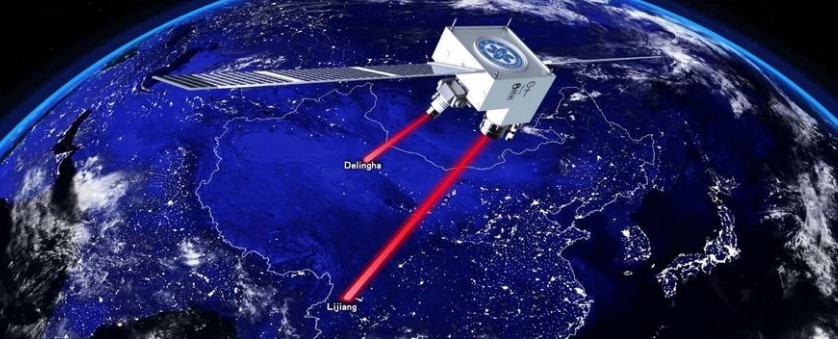China breaks quantum physics record, transmits entangled photons over 1 200 km

For the first time, scientists have realized the satellite-based distribution of entangled photon pairs over a distance of 1 200 km (745 miles). The photon pairs were demonstrated to be still entangled after traveling long distances and Bell's inequality was shown to be violated under strict Einstein locality conditions. The experiment is first measurable proof of idea that has long been theorized. It opens up bright prospects for both practical quantum communications and fundamental quantum optics experiments at distances previously inaccessible on the ground.
The experiment was made through two satellite-to-ground downlinks with a summed length varying from 1 600 – 2 400 km (994 – 1 491 miles). The obtained link efficiency is orders of magnitude higher than that of the direct bidirectional transmission of two photons through telecommunication fibers.
Quantum communication scientists have a fundamental interest in distributing entangled particles over increasingly long distances and studying the behavior of entanglement under extreme conditions. So far, entanglement distribution has only been achieved at a distance up to ~100 km (62 miles) due to photon loss in optical fibers or terrestrial free space.
One way to improve distribution lies in the protocol of quantum repeaters, whose practical usefulness, however, is hindered by the challenges of simultaneously realizing and integrating all key capabilities.
Another approach makes use of satellite- and space-based technologies, as a satellite can conveniently cover two distant locations on Earth. The main advantage of this approach is that most of the photons' transmission path is almost in vacuum, with almost zero absorption and de-coherence.
To prove the feasibility of satellite- and space-based distribution research, ground-based studies were done that demonstrated bidirectional distribution of entangled photon pairs through a two-link terrestrial free-space channel, over distances of 600 m (0.3 miles), 13 km (8 miles), and 102 km (63 miles), with an ~80-dB effective channel loss. Quantum communications on moving platforms in a high-loss situation and under turbulent conditions were also tested.
After these feasibility studies, a quantum science experiment satellite – Micius – was developed and launched from Jiuquan, China on August 16, 2016 with a mission of entanglement distribution. Cooperating with Micius are three ground stations (Delingha in Qinghai; Nanshan in Urumqi, Xinjiang; and Gaomeigu Observatory in Lijiang, Yunnan). The distance between Delingha and Lijiang (Nanshan) is 1203 km (747 mileS). The distance between the orbiting satellite and these ground stations varies from 500 – 2000 km (31 – 1 242 miles).
Due to the fact that the entangled photons cannot be amplified as classical signals, new methods must be developed to reduce link attenuation in satellite-to-ground entanglement distribution. To optimize link efficiency, the scientists combined narrow-beam divergence with a high-bandwidth and high-precision acquiring, pointing, and tracking (APT) technique. By developing an ultra-bright space-borne two-photon entanglement source and high-precision APT technology, the team established entanglement between two single photons separated by 1203 km (747 miles), with an average two-photon count rate of 1.1 Hz and state fidelity of 0.869 ± 0.085. Using the distributed entangled photons, the scientists performed the Bell test at space-like separation and without locality and freedom-of-choice loopholes.
Compared with previous methods of entanglement distribution by direct transmission of the same two-photon source – using the best performance and most common commercial telecommunication fibers, respectively – the effective link efficiency of the satellite-based approach is 12 and 17 orders of magnitude higher, respectively.
Distributed entangled photons are readily useful for entanglement-based quantum key distribution, which, so far, is the only way to establish secure keys between two distant locations on Earth without relying on trustful relay. Another immediate application is to exploit distributed entanglement to perform a variant of quantum teleportation protocol for remote preparation and control of quantum states.
This satellite-based technology opens up bright prospects for both practical quantum communications and fundamental quantum optics experiments at distances previously inaccessible on the ground.
Source: University of Science and Technology of China
Reference:
"Satellite-based entanglement distribution over 1200 kilometers" – Yin et al. – Science – June 16, 2017 – DOI: 10.1126/science.aan3211
Abstract
Long-distance entanglement distribution is essential for both foundational tests of quantum physics and scalable quantum networks. Owing to channel loss, however, the previously achieved distance was limited to ~100 kilometers. Here we demonstrate satellite-based distribution of entangled photon pairs to two locations separated by 1203 kilometers on Earth, through two satellite-to-ground downlinks with a summed length varying from 1600 to 2400 kilometers. We observed a survival of two-photon entanglement and a violation of Bell inequality by 2.37 ± 0.09 under strict Einstein locality conditions. The obtained effective link efficiency is orders of magnitude higher than that of the direct bidirectional transmission of the two photons through telecommunication fibers.
Featured image: An illustration shows China's Micius satellite beaming pairs of entangled photons to receiving stations on Earth. The satellite was used in a record-setting quantum physics experiment. Featured image: Jian-Wei Pan

According to current mainstream physics, quantum entanglement is the process where seemingly pairs or groups of counter-intuitive matter instantly affects each other, for example, the measurement of one particle on Earth instantly affecting another particle at the opposite end of the universe. This is absolutely true, but at the same time it is not proof to the validity of quantum mechanics. Instead, it is proof to the continuity of magnetic fields throughout the Universe. If you subject an electron to a magnetic field, you affect its spin. And if that electron is entangled with another, then any time electron A changes its spin, electron B will react as well, even though it was never subjected to the magnetic field. In physical reality this makes a perfect sense, since magnetic fields are permanently present in the building blocks of matter. Read the rest of the article at the link below
https://www.linkedin.com/pulse/magnetic-entanglement-jamal-shrair?trk=mp-reader-card